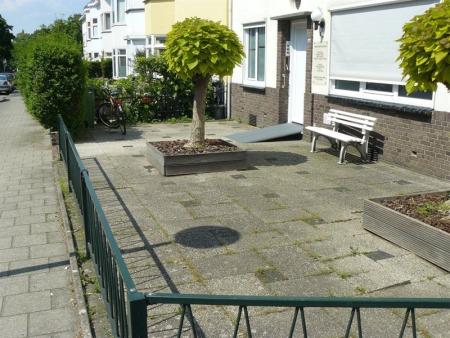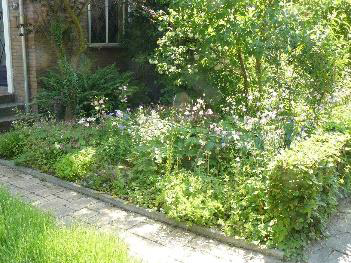
Area characterisation:
Scale of the project: neighbourhood
Scales impacts from this NbS action: neighbourhood
Urban density in which the NbS is implemented: medium
Objective:
Operatie Steenbreek is a foundation that organizes awareness raising campaigns and offers assistance with regards to greening private gardens. Many gardens and streets in the Netherlands are covered with tiles that cannot absorp the rainwater from heavy rainfall.
The idea behind the initiative is to encourage citizens to remove the tiles and stones from their gardens/backyards and replace it with grass, plants and trees for better drainage and to increase the biodiversity.
Thanks to an app., citizens can be adviced and exchange plants with neighbours. Citizens can furthermore measure the performance of their own green garden and discuss the results in focus groups as a kind of citizen science. The initiative calls this form of science the BIMBY (Biodiversity in my back yard) method following Beumer and Martens (Beumer & Martens, 2014; Beumer, 2014).
Images
Financing:
Global (estimated) cost of the project: unknow
Financing mechanism Cluster: cluster4 public private
The project has been replicated in many other municipalities in the Netherlands and it is financed by municipalities. Furthermore, volunteers work for the organization and investements for greening the gardens are done by private citizens. Overall, most of the measures are on a low budget basis.
Potential impacts/benefits:
At a neighbourhood scale impact :
- To raise awareness and offers assitence with regards to greening private gardens
- To increase urban green area in order to drain rainwater and prevent flood risks
- To increase the biodiversity
- Creat social cohesion and enhance citizens projects
- To dissemenate methodologies amongst as many Dutch municipalities as possible
Actions:
Operatie Steenbreek offers help to municipalities in setting up an "Operatie Steenbreek" initiative in their own town or city and adapt it to the local circumstances.
The national platform provides opportunities for municipalities to share information, experiences and knowledge.
The project is already implemented in many cities in the Netherland: Alkmaar, Eindhoven, etc.
Lessons learnt:
Operatie SteenBreek community is structured around a website that creates conditions for citizens to green their gardens and exchange about it. The key point to insure the effectiveness of the initiative is a strong and organized networked organisation which is an hard task concerning citizen projects.
To increase the efficiency of the communication around methodologies, Operatie SteenBreek created the "NbS ambassadors", real Process enablers to bring knowledge to the citizens.
Finally, we can notice the role's ambiguity generated by the complex governance structure, that was the most important governance barrier in this project.
Design team:
The national project was initiated by Alterra, part of Wageningen University, and the University of Groningen. They constitute the contracting authority and the project manager of operative STEENBREEK project.
Other stakeholders:
1. Citizens (As volunteers / To green their gardens)
2. Environmental, ecologist organisations (to offer advice and assistence):
- Groei & Bloei
- Entante Florale
- De vitale groene stad
- Klimaatverbond
- IVN
- Duurzaam Den Haag
- Volgelbescherming (bird protection)
- KNNV (biologists)
3. Knowledge institutes:
- Maastricht University
Contacts:
Carijn , Beumer (Maastricht University, ICIS department)
Contacts here: www.operatiesteenbreek.nl/over-ons/
Stakeholder Participation/Participatory Planning and Governance:
GOVERNANCE MODEL:
Governance Cluster: cluster5 network governance
Governance model: Collaborative governance
It’s a (loosely organised) networked organisation that creates conditions for citizens to green their gardens.
Expected time for the NbS to become fully effective after its implementation: medium (between 2 to 5 years)
Feedback: The project has already been adapted to new requisites. More partners are involved and the project has been replicated in many other municipalities in the Netherlands.
Expected life time of the intervention: more than 30 years
State of progress of the project: Ongoing (project not delivered)
Success and Limiting Factors:
Process enablers:
Knowledge drivers → Awareness → NbS ambassadors
Awareness raising campaign aims to stimulate private citizens to green their gardens Tools and such are meant to remove knowledge barrier for greening gardens
Process inhibitors:
Governance barriers → Complexity of governance structure → Role ambiguity
There are many partners involved. Hence there are issues with ownership (organisational aspect). Furthermore, the project depends on citizens who volunteer to green their garden. There are no other incentives rather than knowledge/ awareness
BUSINESS MODEL:
Business cluster: Social
Business model: Adopt a stewardship role
NBS goals:
- Enhancing sustainable urbanization
- Restoring ecosystems and their functions
- Developing climate change mitigation
- Improving risk management and resilience
- Urban regeneration through nature-based solutions
- Nature-based solutions for improving well-being in urban areas
- Multi-functional nature-based watershed management and ecosystem restoration
- Nature-based solutions and the insurance value of ecosystems
- Increasing carbon sequestration through nature-based solutions
NBS benefits:
- Developing climate change adaptation; improving risk management and resilience
- Flood peak reduction
- Increase infiltration / Water storage
- Increasing infiltration
- Reduce flood risk
- Reduce run-off
- Reducing temperature at meso or micro scale
- Carbon sequestration and storage
- Restoring ecosystems and their functions
- Greater ecological connectivity across urban regenerated sites
- Improve connectivity and functionality of green and blue infrastructures
- Increase achievements of biodiversity targets
- Increase Biodiversity
- Increase quality and quantity of green and blue infrastructures
- Increased cultural richness and biodiversity
- Changing image of the urban environment
- Creation of green jobs relating to construction & maintenance of NBS
- Improve air quality
- Improve water quality
- Increase accessibility to green open spaces
- Increase amount of green open spaces for residents
- Increase awareness of NBS solution & their effectiveness and co benefits
- Increase communities’ sense of ownership
- Increase population & infrastructures protected by NBS
- Increase social interaction
- Increase stakeholder awareness & knowledge about NBS
- Increase well-being
- Increase willingness to invest in NBS
- Provision of health benefits
- Reducing wind speed
- Social inclusion
- Social learning about location & importance of NBS
Further information:
Nature4Cities (https://www.nature4cities.eu/) aims to develop a knowledge diffusion around Nature-Based Solution (NbS) and a decision support platform through new collaborative models.
teenBreek is part of the Nature4Cities's pioneer case studies database, it will feed the observatory, NbS pre-selection and replication tools, gathered into the Geocluster4NBS.
SteenBreek was chosen as a pioneer case study for the following reasons: 1) low budget project. 2) sharing economy (app. to exchange plants).
Nature4Cities project has received funding from the European Union’s Horizon 2020 research and innovation program under grant agreement No 730468.

